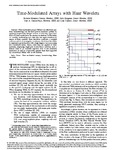Mostrar o rexistro simple do ítem
Time-Modulated Arrays With Haar Wavelets
| dc.contributor.author | Maneiro-Catoira, Roberto | |
| dc.contributor.author | Brégains, Julio | |
| dc.contributor.author | García-Naya, José A. | |
| dc.contributor.author | Castedo, Luis | |
| dc.date.accessioned | 2023-12-11T19:37:40Z | |
| dc.date.available | 2023-12-11T19:37:40Z | |
| dc.date.issued | 2020-11 | |
| dc.identifier.citation | R. Maneiro-Catoira, J. Bregains, J. A. Garcia-Naya, y L. Castedo, “Time-modulated arrays with Haar wavelets”, IEEE Antennas Wirel. Propag. Lett., vol. 19, núm. 11, pp. 1862–1866, 2020. | es_ES |
| dc.identifier.issn | 1536-1225 | |
| dc.identifier.uri | http://hdl.handle.net/2183/34449 | |
| dc.description | © 2020 IEEE. This version of the article has been accepted for publication, after peer review. Personal use of this material is permitted. Permission from IEEE must be obtained for all other uses, in any current or future media, including reprinting/republishing this material for advertising or promotional purposes, creating new collective works, for resale or redistribution to servers or lists, or reuse of any copyrighted component of this work in other works. The Version of Record is available online at: https://doi.org/10.1109/LAWP.2020.2986832 | es_ES |
| dc.description.abstract | [Abstract]. Time-modulated arrays (TMAs) can effectively perform beamsteering over the first positive harmonic pattern by applying progressively delayed versions of stair-step approximations of a sine waveform to the antenna excitations. In this letter, we consider synthesizing such stair-step sine approximations by means of Haar wavelets. Haar functions constitute a complete orthonormal set of rectangular waveforms, which have the ability to represent a given function with a high degree of accuracy using few constituent terms. Hence, when they are applied to the TMA synthesis, employing single-pole double-throw switches, such a feature leads to an excellent rejection level of the undesired harmonics as well as a bandwidth greater than that supported by conventional TMAs with on-off switches. | es_ES |
| dc.description.sponsorship | This work has been funded by the Xunta de Galicia (ED431G2019/01), the Agencia Estatal de Investigación of Spain (TEC2016-75067-C4-1-R, RED2018-102668-T) and ERDF funds of the EU (AEI/FEDER, UE). | es_ES |
| dc.description.sponsorship | Xunta de Galicia; ED431G2019/01 | es_ES |
| dc.language.iso | eng | es_ES |
| dc.publisher | Institute of Electrical and Electronics Engineers | es_ES |
| dc.relation | info:eu-repo/grantAgreement/AEI/Plan Estatal de Investigación Científica y Técnica y de Innovación 2013-2016/TEC2016-75067-C4-1-R/ES/CODIFICACIÓN Y PROCESADO DE SEÑALES PARA REDES EMERGENTES DE COMUNICACIÓN Y DE SENSORES INALÁMBRICAS | es_ES |
| dc.relation | info:eu-repo/grantAgreement/AEI/Plan Estatal de Investigación Científica y Técnica y de Innovación 2017-2020/RED2018-102668-T/ES/RED COMONSENS/ | es_ES |
| dc.relation.isversionof | https://doi.org/10.1109/LAWP.2020.2986832 | |
| dc.relation.uri | https://doi.org/10.1109/LAWP.2020.2986832 | es_ES |
| dc.rights | © 2020 IEEE | es_ES |
| dc.rights | Todos os dereitos reservados. All rights reserved. | es_ES |
| dc.subject | Beamsteering (BS) | es_ES |
| dc.subject | Haar wavelets | es_ES |
| dc.subject | Time-modulated arrays (TMAs) | es_ES |
| dc.title | Time-Modulated Arrays With Haar Wavelets | es_ES |
| dc.type | info:eu-repo/semantics/article | es_ES |
| dc.rights.access | info:eu-repo/semantics/openAccess | es_ES |
| UDC.journalTitle | IEEE Antennas and Wireless Propagation Letters | es_ES |
| UDC.volume | 19 | es_ES |
| UDC.issue | 11 | es_ES |
| UDC.startPage | 1862 | es_ES |
| UDC.endPage | 1866 | es_ES |
| dc.identifier.doi | 10.1109/LAWP.2020.2986832 |
Ficheiros no ítem
Este ítem aparece na(s) seguinte(s) colección(s)
-
GI-GTEC - Artigos [186]






